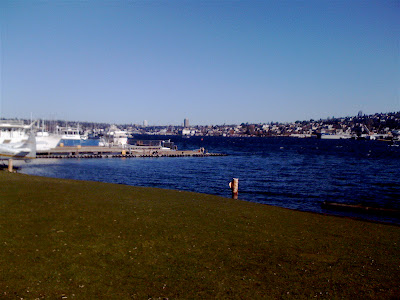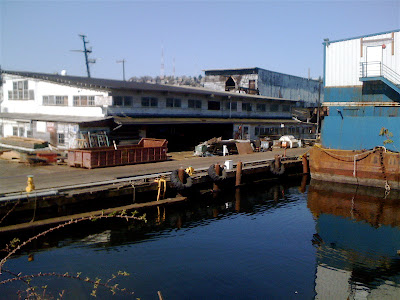This is another part of a story I started to tell you yesterday.
At the south end of Lake Union we've recently built a round, concrete lake for the express purpose of sailing model boats. There in the distance, just beyond the old armory where we used to play gay bingo to raise money for AIDS prevention and research, and where the Museum of History and Industry will soon move, there lies the real lake.
But what do we mean by real? Yes, it's a lake. It appears to us to be a natural body of water that happens to be set in the heart of a major US city.
But it can hardly be called a work of nature. Indeed, this place where water collects was carved out some 13,000 years ago by a glacier, but what we see today is really something relatively new on the face of the earth, a place neither natural nor man made. It's a new kind of place; a hybrid place.
Humans have lived around Lake Union for hundreds of years, first in the form of native Americans, the Duwamish tribe, who largely lived here as they found it, later to be joined by European and Asian immigrants who began the process of changing it into what it is today.
Center for Wooden Boats
The name Lake Union refers to the dream of the Seattle city founders to unify the much larger Lake Washington to the east with Elliott Bay and Puget Sound to the west, for economic reasons, via canals and a complex of locks that now maintain the lakes at 20-22 feet above sea level and prevent the salt water from invading the fresh water. The US Army Corps of Engineers project was started in 1911 and completed in 1934 and forever and fundamentally changing the lake, making it a new kind of thing in the world.
At the time, it was heralded, called by many a "conquest of nature." We were pretty full of ourselves back then, I think, proud as we should be of our ability to accomplish incredible feats with creativity and engineering, working together, through our institutions of government and commerce and education to surmount the insurmountable. Anything seemed possible. We were building dams and bridges, airplanes and rockets. We were moving huge portions of the earth to make it suit us rather than the other way around.
Aurora Bridge: evocative of a cathedral.
Look what we can do! Nothing can stop us!
A view of the I-5 bridge from the University Bridge
It's hard not to be inspired even now. It carried us all the way to the moon.
Future home of the Rachel Carson Park, author of the seminal environmental book
We're not so enthusiastic any more. We've felt the thrills, but we've also experienced the unintended consequences of our actions. The Lake Washington Ship Canal project, for instance, decimated salmon runs and caused untold numbers of animal and plant extinctions.
Located at the north end of the University Bridge, this statue of a Japanese
girl covered in origami cranes anchors the Peace Park, a memorial to those
who died in the atomic bombing of Hiroshima.
We now understand that there is no "conquest of nature," nor feel that it would be a good thing even if we could. We've come to know that there are things we should not do, even though we can. We now understand that any "control" we have of nature is at best temporary, and at worst a threat to our own survival.
It's here along the shores of a place like Lake Union, this hybrid place where we've chosen to raise our children, that we are on the front lines of figuring out what it means to not just live with nature or beside nature, but from within it. Those of us who live in cities are responsible for doing this because we have no other choice.
There must be a place here for our economic pursuits, because that is part of what we've become as a species and to ban or deny that is to be a little less human.
I pass this sign every day and it always makes me smile.
But we know from experience that we can go too far; that perhaps we already have.
There must be places for us to live.
But we're starting to realize that maybe we need to learn to live with less; less stuff, less room, less waste.
And equally important we need places to play.
In this park on the east side of Lake Union there are English cherries and
native cherries that have cross-pollinated to give rise to an entirely new variety of
cherry that did not exist 40 years ago: another kind of hybrid in this hybrid place.
This was a crowd that gathered in Gas Works Park, a park built in the site
of a former gasification plant.
A float plane, a paddle wheel boat, and a dragon boat.
It seems likely to me that this is how we will learn the most about living in this strange, new place we are creating: through our play. It's where we will perform the experiments, discover the beauties, and uncover the dangers.
Every city is a story, and this is Seattle's story, the story of which we've chosen to make our children an active part.
We must understand our story because otherwise how can we teach these children who are growing up right here in this strange place that is neither natural nor man made?
This is an important part of the journey we at Woodland Park are on together: understanding the place in which we work, live and play. We don't know exactly where our journey is taking us, but our little flotilla of kayaks is heading inexorably there, toward the center of the universe.
The bridges will open for us.
The way may not be what we expected.
But even here, in this hybrid place, goslings are born and thrive.
In the foreground is some kind of electrical facility providing an essential service to I don't
know how many of us. In the distance, if you look carefully you'll see the Space Needle,
a symbol of hope built for the World's Fair in 1962. In between is Lake Union,
not an obstacle, but a fact of who we are becoming as we play our way toward
the future that will not be so George Jetson after all.
This is our children's place.
A place that they shape.
A place that shapes them.
A place where they are growing up dreaming.
Here at the center of the universe.
It's a story I'll keep telling for as long as it takes to tell. We will get there, children, I promise. Reach down for a moment and let your fingers touch the water.



















































1 comment:
This is so interesting, I'll continue to read.
(I'm just now reading an interesting novel by Annie Dillard, "The Living", which takes place in late 1800's in this area of the world. What a lot of work it took to clear land, and create the human settlements... and now as you say perhaps human ingenuity went too far, time to rethink, and find new directions, and listen to, and consider the children.) :)
Brenda
Post a Comment